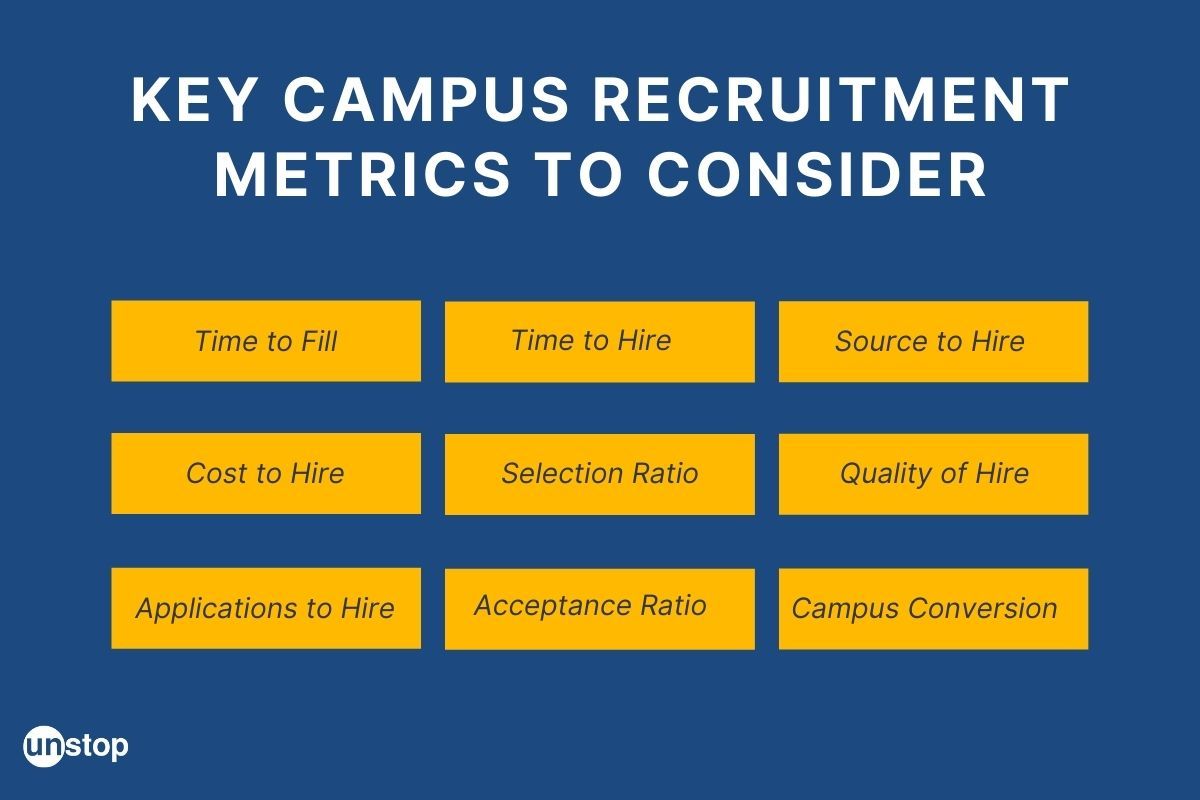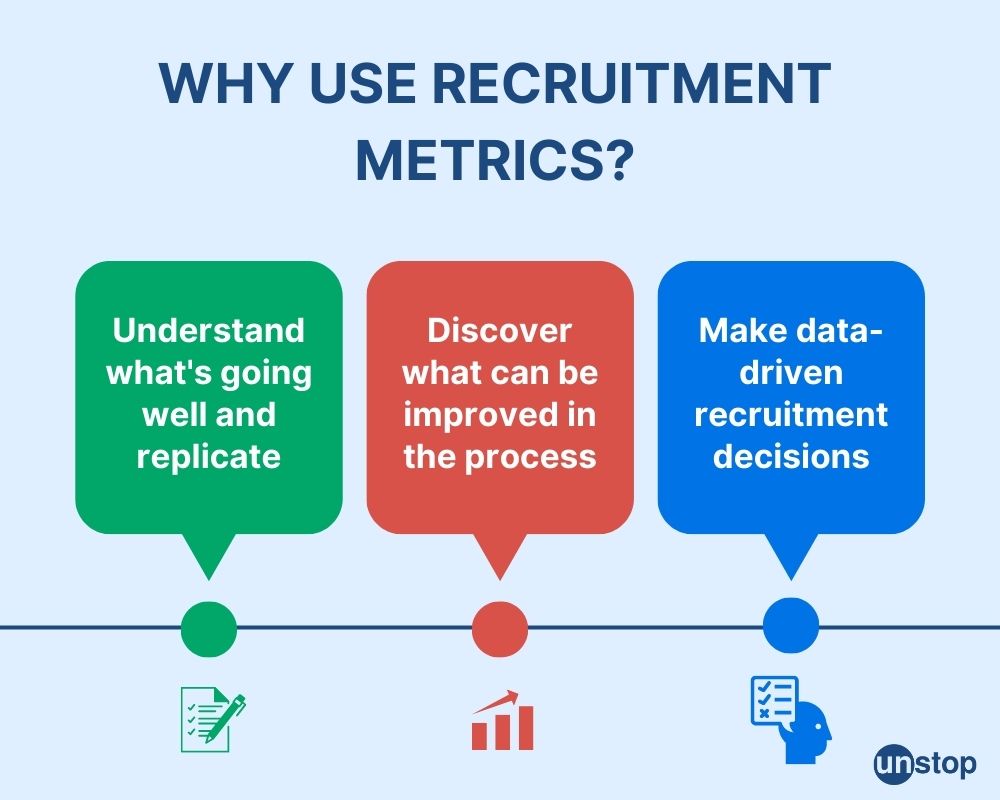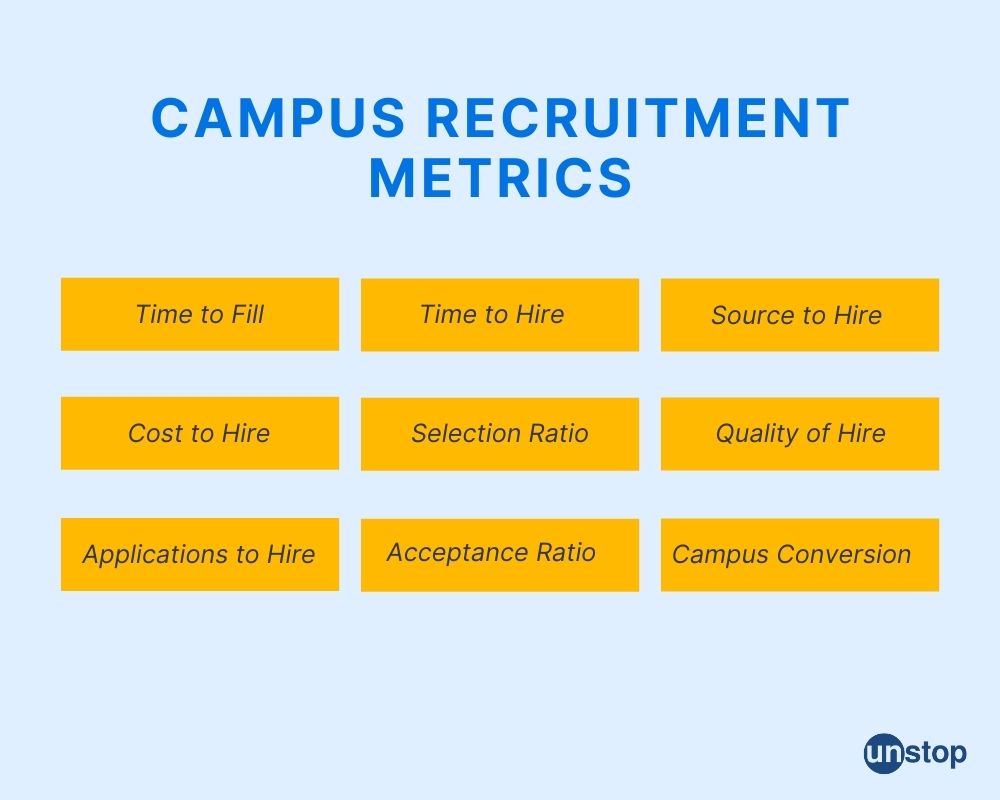- What Are Campus Recruiting Metrics?
- Why Use Campus Recruiting Metrics?
- The Nine Metrics That Matter The Most
- How To Track
- Improving The Metrics
Campus Recruiting Metrics: The Key To Creating Effective Hiring Strategies

From exam scores to competition results, we've always used metrics to understand our performance in different areas. It's only when we measure and analyze performance, that we can learn, improve and become better than yesterday. This stands true not just for people's performances, but also for organizations.
The best organizations are the ones that understand what drives success, and areas where there is a scope for improvement - across all functions, including hiring and talent acquisition. This is where recruitment metrics come into play.
As the name suggests, recruitment metrics measure the success rate of a company's recruitment strategy - and it goes beyond just calculating the total number of hires. Recruitment, today, has several sub-sections - from campus recruitment to talent-based lateral hiring and more. Recruitment metrics focus on each sub-section, along with the overall results.
In this piece, we'll go through campus recruitment metrics, their importance, ways to track them, and important metrics to track.
What Are Campus Recruiting Metrics?
The campus recruitment landscape has never been more rife with competition. Organizations, on the lookout for the next wave of talented employees, are regularly engaging with university career centers and recruiting on campus.
However, a campus recruitment strategy is only as effective as the results it yields. Thus, it's important to utilize campus recruiting metrics or Key Performance Indicators (KPIs) and calculate the ROI (Return on Investment) of an organization's campus recruitment drives.
As Admiral Grace Hopper put it, "One accurate measurement is worth a thousand expert opinions."
Campus recruiting metrics are indicators that measure the performance of the campus recruitment strategy. These metrics cover various aspects of the campus recruitment process - from the time taken to hire to the selection ratio.
After all, it's not just the number of qualified candidates applying for an open role that's important, but also the time taken to source these candidates.

Why Should Organizations Track Campus Recruiting Metrics?

It's fairly obvious why campus hiring indicators are important. But here are the three major benefits of tracking metrics:
Understand what's going well
The biggest advantage of utilizing metrics is that it gives organizations a clear idea of what recruitment practice is working well and driving the desired results. The recruitment team can accordingly draft strategies and allocate the budget for hiring activities.
Discover what can be improved
Metrics also help the TA team figure out what can be improved in the recruitment process. This ensures that organizations are not throwing money down the drain by continuing ineffective practices. This can enable them to plan better for future recruitment drives.
Make data-driven decisions
Companies are increasingly relying on insights driven by analytics and for good reason. Organizations can improve their recruiting efforts and reduce costs by making data-driven recruitment decisions.
The Nine Metrics That Matter The Most

Now that we've understood why tracking recruitment metrics is important, let's take a look at nine of the most important campus recruitment metrics:
Time to Fill
Time-to-Fill tracks the time taken to fill the vacancy - from the time the job posting was approved to the time it closed. It's measured by simply calculating the number of calendar days from the time the job requisition was approved to the time the candidate accepted the offer.
Why it's important - This metric gives hiring managers a realistic idea about the total time it will take to hire a new employee. It's incredibly important when planning to replace an employee who's leaving the organization, or looking to start a new project that requires additional workforce (as might be the case in case of campus hires).
Time to Hire
Time-to-Hire measures the time taken from the time a candidate applies for the open role to the moment they accept the job offer. It's different from time-to-fill because here, the starting point is when the candidate applies for the role, not when the organization/concerned team approves the job requisition. It's also referred to as the time taken to accept.
Why it's important: The metric shows the effectiveness of the recruitment cycle i.e. how quickly a candidate moves through the entire recruitment cycle. It also helps identify bottlenecks, if any - steps that may be delaying the process - for example, multiple rounds of interviews for assessing the same skill set. A shorter time to hire is generally preferable.
Source to Hire
Source to hire looks at the effectiveness of the various sourcing channels being used to source candidates. From job boards to recruitment platforms, the HR team can utilize multiple recruitment channels to invite candidates to apply for the role. Sourcing channel effectiveness paints an accurate picture of the recruitment channels that actually work for an organization.
Why it's important: This metric allows the team to understand which sources of hire are garnering more attention, giving a clear indication of the sources preferred by candidates and those that have the maximum reach. Thus, instead of spending thousands of dollars on all sourcing platforms, organizations can focus on those that deliver better results.
Applicant to Hire
Also referred to as applicant per opening, this metric tracks the total number of applications received for an opening. However, remember, a job's popularity does not automatically translate to a higher number of qualified candidates. To ensure that you receive qualified candidates, be clear in your job description and criteria for applying.
Why it's important: This metric shows how in-demand a role is, allowing organizations to adequately devise compensation packages, hiring timelines, etc.
Selection Ratio
The selection ratio measures the percentage of candidates selected for the role, from the total number of potential candidates who applied for the role. If the selection ratio is low i.e., only a small number of candidates were selected from a large pool of applications, it's an indication of the job's and/or company's popularity, the reach of job sources, and the strength of the assessment tool, among other factors.
Why it's important: The selection ratio enables organizations to better manage the hiring process by setting realistic timelines, drafting stringent assessment frameworks, etc.
Offer Acceptance Rate
The offer acceptance rate is measured by dividing the total number of candidates who accepted the job offer by the total number of offers made. It's different from the selection ratio because the denominator is different. While the selection ratio looks at all the applicants who applied for the role, the acceptance ratio looks at the people who eventually accept the offer.
For example, if out of 10 candidates who applied for the role, three were extended an offer letter and two accepted the offer, the selection ratio will be 3/10, but the offer acceptance rate will be 2/3.
Why it's important: A low acceptance rate shows a flaw in the organization's compensation package or job offer. It could be the value of the offer, the timing, or a combination of both. Knowing this can help organizations improve their offering, and save time and resources.
Cost Per Hire
One of the most common recruitment metrics is cost per hire. This metric divides the total recruitment cost with the total number of hires to arrive at the average cost of the hiring process. It takes into account all associated costs with recruitment. Thus, in the case of campus recruitment, this will include the cost of advertising, physical visits to the campus, other internal or external costs, etc.
Why it's important: Hiring managers need to track if the recruitment efforts are in line with the assigned budget. It also indicates if the recruiting strategy needs to be tweaked to account for additional expenses.
Quality of Hire
The recruiting team is concerned not just with the number of people hired but also with the quality of hire. This metric helps hiring managers understand how well a hired candidate is performing - especially in the first year. Depending on the role, different indicators may be used to judge the candidate's job performance and arrive at the quality of hire.
Why it's important: A bad hire can cost the company dearly because of the time, effort, and money spent in recruiting and training that candidate. Thus, it's important to track the first-year performance of candidates and determine the quality of hire.
Campus Conversion Rate
While the above metrics are common across various roles, the campus conversion rate is specific to campus recruitment, and thus a key recruiting metric. Campus conversion measures the number of candidates converted from a campus. This metric, coupled with other relevant metrics, can help organizations improve campus recruitment effectiveness.
Why it's important: Organizations invest considerable resources invested in recruiting from campuses. However, if a certain college or campus is not providing the desired quantity or quality of applications, then organizations need to reevaluate their campus recruitment plan and choose different campuses. The campus conversation rate can help streamline an organization's campus recruitment efforts.
Point to note: Metrics can differ across each company and even recruitment drive, depending on the end goal. It's important to use the metrics that best suit your needs, rather than incorporating all available metrics.
Other Important Metrics To Consider
Apart from the aforementioned key metrics, here are additional metrics that organizations can track to evaluate hiring practices:
Diversity & Inclusion: Today, diversity and inclusion are important for any organization to thrive. Thus, recruitment teams focus on these metrics at the time of hiring as well. By analyzing the data of applicants, organizations can understand if their job description and organization are drawing a diverse set of candidates or not. At times, organizations may even set up specific recruitment drives to improve their D&I mandates.
First-Year Attrition: The first-year attrition rate specifically calculates the employees who depart the company within the first year of employment. This ratio can help organizations identify if there are any lags in the onboarding process, training program, or the original hiring strategy. Unmanaged attrition in the first year can impact the overall retention rate of the company.
Application Completion Rate: The job application completion rate evaluates the number of candidates who successfully complete the application and the average time taken for completion. A long-drawn-out application process or application forms that are difficult to navigate and fill can deter candidates from applying. Not only does this affect the candidate's experience, but it can also hamper the quality of candidates who apply.
Candidate Experience: Today, job seekers have as many options as job recruiters. Cultivating a positive candidate experience during hiring can improve your chances of recruiting better talent. It also goes a long way in building the brand image. Organizations can use social media engagement, former employee reviews, etc. to evaluate a candidate's overall experience, from job search to getting hired.
There are several other metrics available to measure hiring strategies, like vacancy rate (open jobs versus total position in the company) or recruitment funnel effectiveness, etc. But choosing the right set of metrics is important.
The metrics should align with the Company's Hiring goals
Each organization has a different set of metrics, depending on the company goals and strength of the talent acquisition team. However, the metrics should always align with overall hiring goals.
Randomly selecting different indicators to evaluate the hiring process will not benefit the organization. And it may actually hamper recruitment practices since decisions will be made on incorrect data. Thus, it's important to align the campus hiring metrics against the company's overall hiring goals.
Here's an example of certain business goals that organizations may have for the campus recruitment program, and the corresponding metrics
| Goal | Campus Recruitment KPIs |
| Improving the speed of hiring |
Time to Fill Time to Hire Application Completion Rate |
| Reducing the cost of hiring |
Time to Hire Cost to Hire Source to Hire Campus Conversion Rate |
| Increasing the number of candidates |
Application to Hire Time to Fill Time to Hire |
How To Track Campus Recruiting Metrics
Data received from campus recruiting metrics can only work if the metrics are properly tracked and analyzed. Here's a step-by-step approach to tracking these metrics:
i) What to collect: The first step is to shortlist the metrics. These metrics should be clearly defined and align with business goals.
ii) How to collect: There should be absolute clarity on how the data is to be collected. This means clarifying the frequency of collection (annually, monthly, quarterly, etc.), the mode of collection (online, offline, or both), the person responsible for collection, etc.
iii) The basis of recruitment analysis: The concerned teams should coordinate with the talent acquisition team to determine how the collected data will be analyzed and what is the minimum threshold or pass percentage for a particular metric.
iv) Reporting results: The time and format of reporting results also need to be specified.
Improving Campus Recruiting Metrics
Organizations can improve their recruiting metrics by following certain best practices, namely:
- Ensuring all aspects of the metrics are well defined, from their scope to frequency.
- Continuously tracking and reporting data. This ensures that results are based on accurate information and any major deviation is immediately dealt with.
- Using technology to streamline the process. Depending on an organization's needs, this can be a campus hiring platform, an online assessment tool, proctoring software, etc.
- Focusing on accountability i.e., assigning responsibility for specific tasks to the concerned team and/or individuals.
Campus recruiting metrics are incredibly important for any organization. Investing time and effort in developing these metrics and tracking their results is bound to improve the effectiveness of recruitment strategies.
Suggested Reads:
- Campus Hiring Platform: Why Do You Need It & How To Find The Best One?
- Step-By-Step Approach To Building A Winning Campus Recruitment Strategy
- What is Campus Recruitment? How To Tap The Untapped Talent?
- Lateral Hiring: A Complete Guide To The Process, Its Benefits, Challenges & Best Practices
- Lateral vs Fresher Hiring: Which Is A Better Choice?
I’m a reader first and a writer second, constantly diving into the world of content. If I’m not writing or reading, I like watching movies and dreaming of a life by the beach.
Login to continue reading
And access exclusive content, personalized recommendations, and career-boosting opportunities.
Subscribe
to our newsletter
Blogs you need to hog!

Organize Hackathons: The Ultimate Playbook With Past Case Studies

What is Campus Recruitment? How To Tap The Untapped Talent?

Lateral Hiring: A Complete Guide To The Process, Its Benefits, Challenges & Best Practices













Comments
Add comment